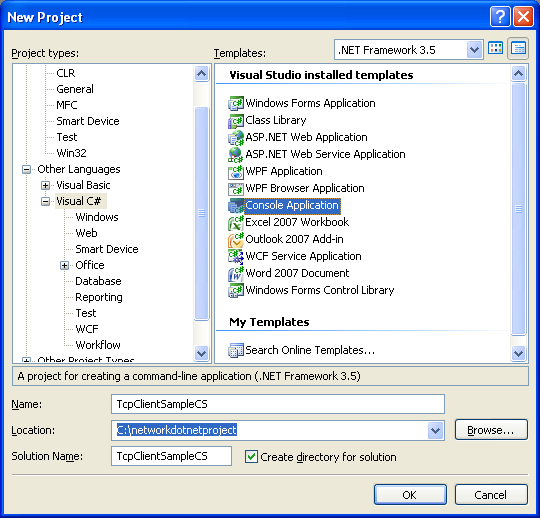< VB .NET TcpListener & C++ .NET TCP Client Examples | Main | C++ and C# UDP Client & Server Examples >
Chapter 8 Part 30:
Client (and Server) Sockets Communication
What do we have in this chapter 8 Part 30?
-
C# TCP Client Program Example
-
VB .NET TCP Client Program Example
|
|
C# TCP Client Program Example
Create a new console application project and you might want to use TcpClientSampleCS as the name.
|
Next, rename the class to TcpClientSample by renaming the source file.
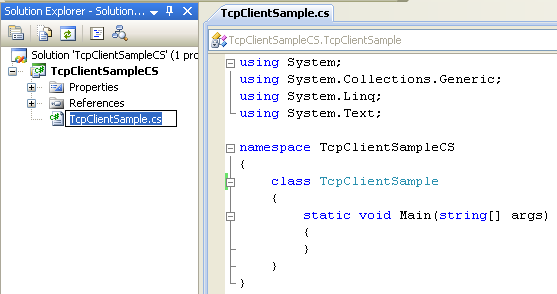
Add/edit the following using directives at the top of the file.
|
using System; using System.Net; using System.Net.Sockets; |
Add the following method for the TcpClientSample class.
|
/// <summary> /// Displays simple usage information. /// </summary> static public void usage() { Console.WriteLine("usage: TcpClientSample.exe [-n server] [-p port] [-x size]"); Console.WriteLine("Available options:"); Console.WriteLine(" -n server Name or address of server to connect to"); Console.WriteLine(" -p port Port number to connect to server on"); Console.WriteLine(" -x size Size of send and receive buffers"); Console.WriteLine(); } |
Next, add the Main() code.
|
static void Main(string[ ] args) { // Initial/default values string serverAddress = "localhost"; ushort serverPort = 5150; int bufferSize = 1024;
usage();
// Parse the command line for (int i = 0; i < args.Length; i++) { try { if ((args[i][0] == '-') || (args[i][0] == '/')) { switch (Char.ToLower(args[i][1])) { case 'n': // String name or address of server to connect to serverAddress = args[++i]; break; case 'p': // Port number for the destination serverPort = System.Convert.ToUInt16(args[++i]); break; case 'x': // Size of the send and receive buffers bufferSize = System.Convert.ToInt32(args[++i]); break; default: usage(); return; } } } catch { usage(); return; } }
TcpClient simpleTcp = null; NetworkStream tcpStream = null; byte[] sendBuffer = new byte[bufferSize], receiveBuffer = new byte[bufferSize], byteCount; int bytesToRead = 0, nextReadCount, rc;
// Initialize the send buffer Console.WriteLine("TCP client: Initializing the send buffer..."); for (int i = 0; i < sendBuffer.Length; i++) sendBuffer[i] = (byte)'X';
try { // Create the client and indicate the server to connect to Console.WriteLine("TCP client: Creating the client and indicate the server to connect to..."); simpleTcp = new TcpClient(serverAddress, (int)serverPort);
// Retrieve the NetworkStream so we can do Read and Write Console.WriteLine("TCP client: Retrieving the NetworkStream so we can do Read and Write..."); tcpStream = simpleTcp.GetStream();
// First send the number of bytes the client is sending Console.WriteLine("TCP client: Sending the number of bytes the client is sending..."); byteCount = BitConverter.GetBytes(sendBuffer.Length); tcpStream.Write(byteCount, 0, byteCount.Length);
// Send the actual data Console.WriteLine("TCP client: Sending the actual data..."); tcpStream.Write(sendBuffer, 0, sendBuffer.Length); tcpStream.Read(byteCount, 0, byteCount.Length);
// Read how many bytes the server is responding with Console.WriteLine("TCP client: Reading how many bytes the server is responding with..."); bytesToRead = BitConverter.ToInt32(byteCount, 0);
// Receive the data Console.WriteLine("TCP client: Receiving, reading & displaying the data..."); while (bytesToRead > 0) { // Make sure we don't read beyond what the first message indicates // This is important if the client is sending multiple "messages" -- // but in this sample it sends only one if (bytesToRead < receiveBuffer.Length) nextReadCount = bytesToRead; else nextReadCount = receiveBuffer.Length;
// Read the data rc = tcpStream.Read(receiveBuffer, 0, nextReadCount);
// Display what was read string readText = System.Text.Encoding.ASCII.GetString(receiveBuffer, 0, rc); Console.WriteLine("TCP client: Received: {0}", readText); bytesToRead -= rc; } } catch (SocketException err) { // Exceptions on the TcpListener are caught here Console.WriteLine("TCP client: Socket error occurred: {0}", err.Message); } catch (System.IO.IOException err) { // Exceptions on the NetworkStream are caught here Console.WriteLine("TCP client: I/O error: {0}", err.Message); } finally { // Close any remaining open resources Console.WriteLine("TCP client: Closing all the opening resources..."); if (tcpStream != null) tcpStream.Close(); if (simpleTcp != null) simpleTcp.Close(); } } |
Next, build the project and make sure there is no error.
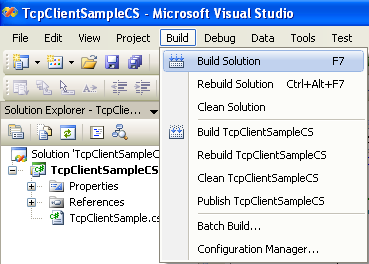
Then, run the project. Any error will be thrown by the exception handlers.
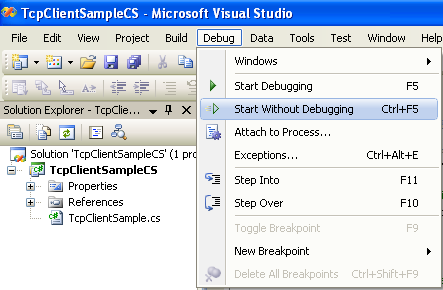
The following is the sample output.
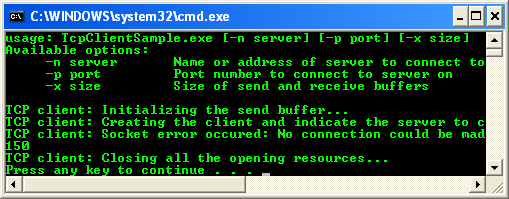
The following are sample outputs when run at the command prompt for tcp listener and tcp client. The listener program used is the previously created, TcpListenerSampleCS.exe. Firstly, we run the listener. The listener is waiting a connection from client.
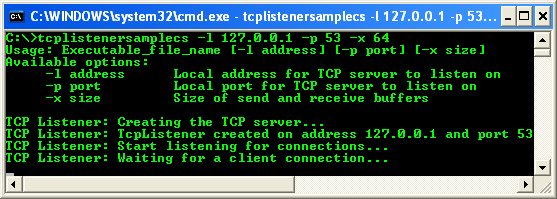
Then we run the tcp client.
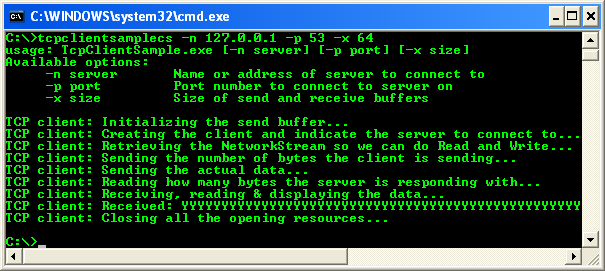
The following is the tcp listener output screenshot when the communication was completed.
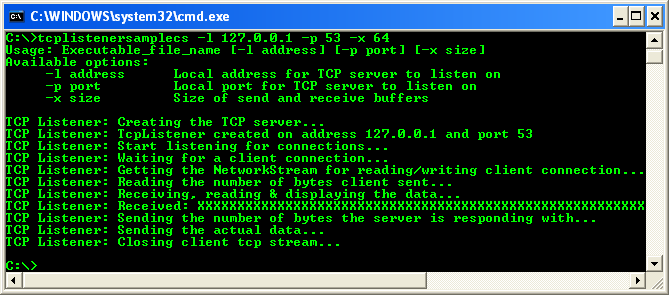
You may want to test this program on real network with the listener and the client run on different hosts and try using different available options.
VB .NET TCP Client Program Example
Create a new class library project and you might want to use TcpClientSampleVB as the name.
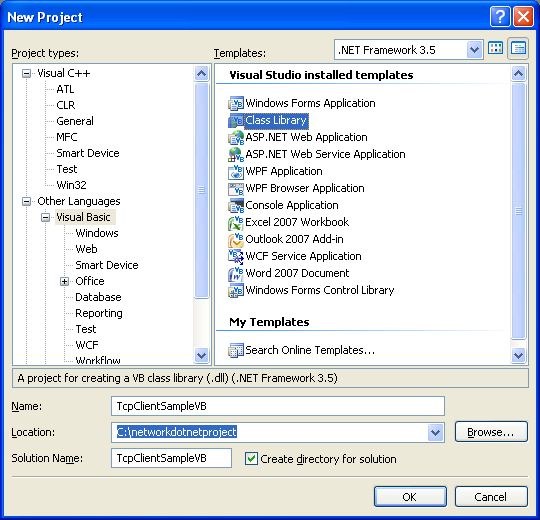 |
|
Next, rename the class to tcpclientsample by renaming the source file name.

Add/edit the following Import directives at the top of the file.
|
Imports System Imports System.Net Imports System.Net.Sockets |
Next, add the usage() subroutine code
|
' Displays simple usage information. Shared Sub usage() Console.WriteLine("Usage: TcpClientSampleVB [-n server] [-p port] [-x size]") Console.WriteLine("Available options:") Console.WriteLine(" -n server Name or address of server to connect to") Console.WriteLine(" -p port Port number to connect to server on") Console.WriteLine(" -x size Size of send and receive buffers") Console.WriteLine() End Sub |
Then, add the Main() subroutine code.
|
Shared Sub Main() Dim serverAddress As String = "localhost" Dim serverPort As Short = 5150 Dim bufferSize As Integer = 1024
' Parse the command line Dim args As String() = Environment.GetCommandLineArgs() Dim i As Integer
usage()
For i = 1 To args.GetUpperBound(0) Try Dim CurArg() As Char = args(i).ToCharArray(0, args(i).Length) If (CurArg(0) = "-") Or (CurArg(0) = "/") Then Select Case Char.ToLower(CurArg(1), System.Globalization.CultureInfo.CurrentCulture) Case "n" ' String name or address of server to connect to i = i + 1 serverAddress = args(i) Case "p" ' Port number for the destination i = i + 1 serverPort = System.Convert.ToInt16(args(i)) Case "x" ' Size of the send and receive buffers i = i + 1 bufferSize = System.Convert.ToInt32(args(i)) Case Else usage() Exit Sub End Select End If
Catch e As Exception usage() Exit Sub End Try Next
Dim simpleTcp As TcpClient = Nothing Dim tcpStream As NetworkStream = Nothing Dim sendBuffer(bufferSize) As Byte Dim receiveBuffer(bufferSize) As Byte Dim byteCount() As Byte Dim bytesToRead As Integer = 0 Dim nextReadCount, rc As Integer
' Initialize the send buffer Console.WriteLine("Initializing the send buffer...") For i = 0 To sendBuffer.GetUpperBound(0) - 1 sendBuffer(i) = CByte(65) Next
Try ' Create the client and indicate the server to connect to Console.WriteLine("Creating the client and indicate the server to connect to...") simpleTcp = New TcpClient(serverAddress, serverPort)
' Retrieve the NetworkStream so we can do Read and Write Console.WriteLine("Retrieving the NetworkStream so we can do Read and Write...") tcpStream = simpleTcp.GetStream()
' First send the number of bytes the client is sending Console.WriteLine("Sending the number of bytes...") byteCount = BitConverter.GetBytes(sendBuffer.GetUpperBound(0)) tcpStream.Write(byteCount, 0, byteCount.GetUpperBound(0))
' Send the actual data Console.WriteLine("Sending the actual data...") tcpStream.Write(sendBuffer, 0, sendBuffer.GetUpperBound(0)) tcpStream.Read(byteCount, 0, byteCount.GetUpperBound(0))
' Read how many bytes the server is responding with Console.WriteLine("Reading how many bytes the server is responding with...") bytesToRead = BitConverter.ToInt32(byteCount, 0)
' Receive the data Console.WriteLine("Receive, read & display the data...") While (bytesToRead > 0)
' Make sure we don't read beyond what the first message indicates ' This is important if the client is sending multiple "messages" -- ' but in this sample it sends only one If (bytesToRead < receiveBuffer.GetUpperBound(0)) Then nextReadCount = bytesToRead Else nextReadCount = receiveBuffer.GetUpperBound(0) End If
' Read the data rc = tcpStream.Read(receiveBuffer, 0, nextReadCount)
' Display what was read Dim readText As String = System.Text.Encoding.ASCII.GetString(receiveBuffer, 0, rc) Console.WriteLine("Received: {0}", readText) bytesToRead -= rc End While
Catch err As SocketException ' Exceptions on the TcpListener are caught here Console.WriteLine("Socket error occurred: {0}", err.Message)
Catch err As System.IO.IOException ' Exceptions on the NetworkStream are caught here Console.WriteLine("I/O error: {0}", err.Message)
Finally ' Close any remaining open resources Console.WriteLine("Closing any remaining open resources...") If (Not IsNothing(tcpStream)) Then tcpStream.Close() End If
If (Not IsNothing(simpleTcp)) Then simpleTcp.Close() End If End Try End Sub |
We need to change the DLL to EXE type program so that we can run it n console mode. Select the project folder > Right click mouse > Select Properties context menu.
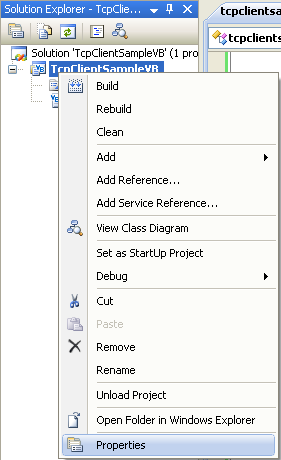
Change the Application type: to Console Application and the Startup object: to Sub Main.
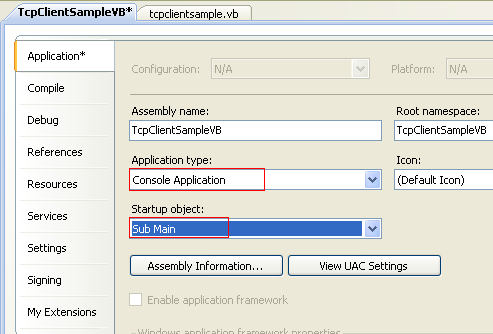
Next, build the project and make sure there is no error that can be seen in the Output window if any.
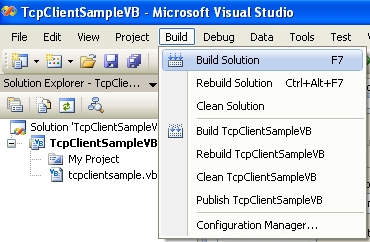
Then, run the project. Any error will be thrown by the exception handlers.
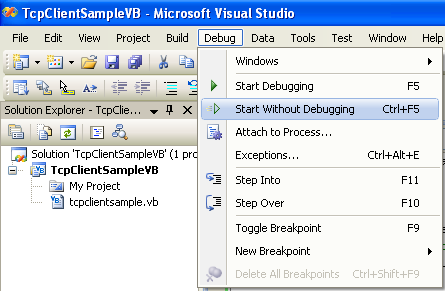
The following is the sample output.
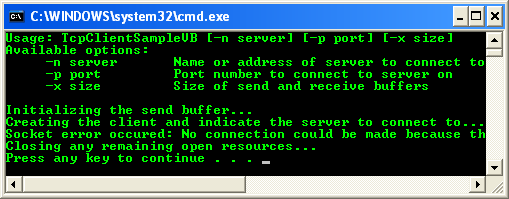
Testing the tcp client with the tcp listener. The tcp listener is a TcpListenertSampleVB program that was created previously. Firstly, we run the listener at the command prompt (in this case both client and the listener executables were copied to the C:\).
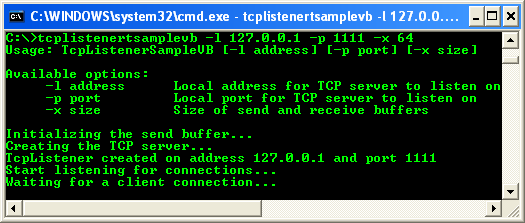
If the following Windows Security Alert box displayed, click the Unblock button.
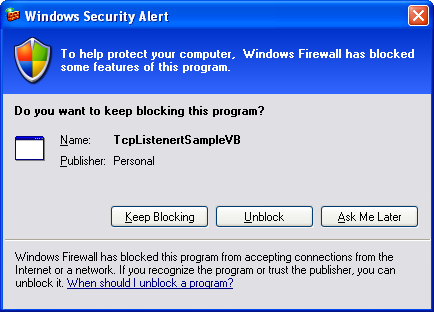
Then, we run the tcp client program.
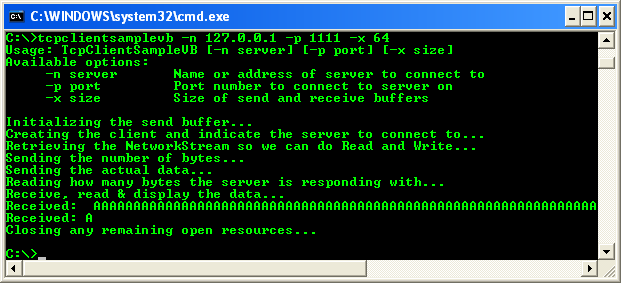
The following is the tcp listener output screenshot after the communication was completed.
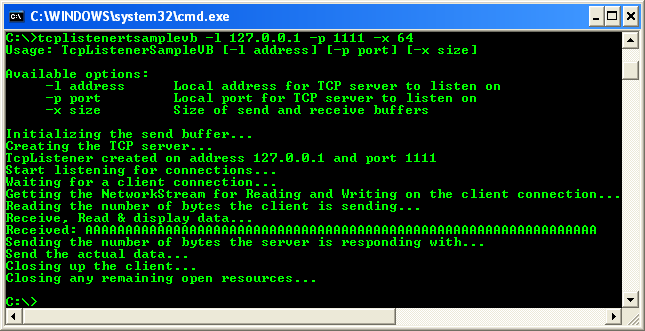
Well, you may want to test this program on real network with the listener and the client run on different hosts and try using different available options.
